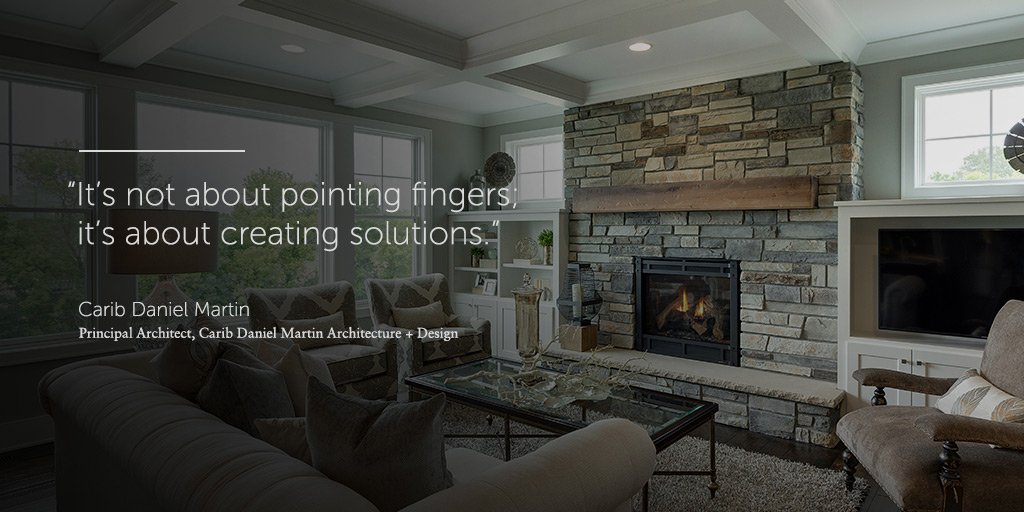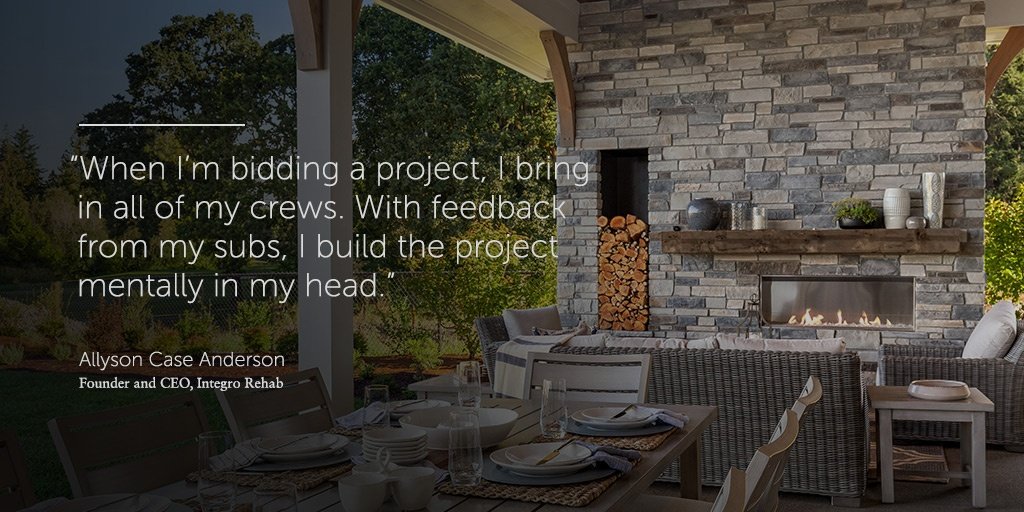
The architect-contractor relationship is the most important one of the building process after your relationship with your client. Here’s how to make it stronger.
While there is plenty of guidance out there on “how to hire a contractor” and “how to hire an architect,” one often overlooked component of a successful residential construction project is the relationship between the builder and the architect.
Frequently, homeowners find an architect or find a builder separately and don’t look at the two as part of an integrated team, which can often be a recipe for disaster. But whether or not you have some say about the architect or builder with whom you work (the ideal scenario), or whether the relationship is a new one initiated by your customer, there’s no reason you can’t build a solid foundation together to achieve your client’s needs and goals.
Washington, D.C.-based residential architect Carib Daniel Martin of Carib Daniel Martin Architecture + Design and home builder, renovator, and restoration expert Allyson Case Anderson, founder and CEO of Integro Rehab in Chicago, sat down with Cultured Stone to discuss how to perfect that design-build relationship:
Related Reading: Green Building Materials: 5 Sustainable Resources for Your Next Project

Why is it critical for the architect and builder to have an ongoing and trusting relationship throughout the home construction process?
Martin: “Every project has three main players: the client, the builder, and the architect. Historically the architect-contractor relationship has been one of an ‘us versus them’ mentality. But we’re both after the same thing: a beautiful project, a happy client, and a profitable job.
“If you don’t have a good relationship, poor quality of life is going to be a side effect. I want to enjoy what I do. I don’t want to constantly fight the people I’m relying on to bring my project to a reality. A good relationship [with the builder] comes back to you: you get what you designed built the way you want it, and issues that do come up get resolved more peacefully. It’s not about pointing fingers; it’s about creating solutions.
“It also makes for a better relationship with the client. Clients aren’t going to be happy if you design something and then they find the cost is crazy because the builder wasn’t involved in the process on the frontend.”
Anderson: “A bad relationship [with the architect] can get you fired or lead you into a lawsuit. Most of the time when those things happen, they could have been avoided with better communication.
“[Lack of communication] also leads to rework, and our number one goal is to avoid rework. Apart from the cost, it kills morale on the job site.
“If there is a disagreement between the builder and the architect, and they don’t have a good working relationship in place, things will go south, and they’ll go south fast because the client doesn’t know who to believe.”

Why is it important for both the architect and builder to be part of the construction process from the beginning…before any plans are drawn?
Martin: “We want clients to get a contractor involved early in the project, so that he or she is involved in the design process. At that preliminary design meeting, when we’re talking project size, space needs, etc., we want the contractor at the table as well. The builder can flag issues that could lead to increased costs early on, and he or she can also help us revise numbers as a design evolves and is refined.”
Anderson: “Building projects don’t start with construction; they start with design. We love working with architects who ask their clients to qualify the contractor in the very early stages of design. That way we’re working on pricing and goals together all the way through. A good architect will put the builder on board early.
“When I’m bidding a project, I bring in all of my crews. With feedback from my subs, I build the project mentally in my head. If we see any major flaws in the bidding process that could be seriously consequential, we can address them on the frontend.
“Once we start construction, then we as the builder take the lead, but we treat the architect as an advocate for the client and use him or her as a point of accountability. Everything we do has to be signed off by the architect.
“Plus, it’s a lot easier if there is a change order for the clients to understand and readily pay for it if the architect is advocating for it, too. It also gives us another layer of advocacy.”
What are three things you wish architects/builders understood better about the design or construction process?
Martin: “Please pay attention to the drawings that I’m giving you because if I spent the time to draw it and specify it, then that’s how I want it.
“The other big thing is supervision, and maybe this is more for the client. Price differences on contractors, by and large, are the result of two factors: the cost of supervision and the quality of the subcontractors. The cheaper guy is using cheaper subcontractors and isn’t providing as much supervision.
“And finally don’t hesitate to call. I’d rather answer questions [about the design] before they become issues on the job.”
Anderson: “On projects that have a heavy sustainability focus, [it’s important to remember] a lot of those technologies are new or emerging. Often architects pitch these new technologies as being more efficient and cost saving, but until the builder has seen it and has experience with it, there is no cost savings because carpenters are going to be nervous about things they’ve not tried previously.
“I’d like to see more architects take accountability for review of shop drawings and sketches. We’ll often send an architect the shop drawings, and he or she will approve it even when it’s
wrong because there isn’t a thorough review.
“Some architects don’t do interior design, and if they don’t, it would be really helpful if they state upfront that the client also needs to hire an interior designer. In a typical bathroom, there are 25+ finishes that need to be decided upon, from door hinges to faucets.”
Related Reading: 3 Expert Architecture Tips: Design Smart Now to Avoid Costly Errors Later
What are the most common conflicts that can result in the builder-architect relationship?
Martin: “The whole concept of the relationship can cause conflict: the architect may think the builder doesn’t care or pay attention to the drawings, and the builder may think the architect doesn’t understand construction.
“The most common point of conflict I’ve seen is where builders haven’t paid attention to drawings. For example, you may notice the light switches aren’t what you specified, but the contractor will say, ‘this is how we always do it.’ You have to be clear and specify what you want.
Framing can be another frustrating point of contention. You may meet with the builder and framing crew and tell them to be aware of a shower head in a particular location and frame accordingly. It doesn’t seem to matter in the moment, but it does later. Framing issues are huge – – it’s critical to leave space for things the architect requests.”
Anderson: “Most of the issues that come up are in finish carpentry because it’s the hardest thing for architects to draw. Finish work will go up pretty quickly, and sometimes the architect will say, ‘that’s not quite what it’s supposed to look like.’ Carpenters are the most prideful of all the trades, and no one wants to do rework.”
What advice can you offer for fostering a good working relationship and solid communication with a builder or architect?
Martin: “Spend a lot of time upfront communicating with the builder. I will do anything I can prior to signing the contract to make sure the builder understands the project well and that we have an accurate bid. Once the contract is signed, I’m duty-bound to be the client’s representative on that contract. So it’s also important to let the contractor know you’re a firm representative of the client, so he or she will understand the boundaries.
“Before you start work with any trade, take a walk with that person to make sure he or she understands the job and is doing it right. Let him or her know you want to help. Be giving but firm.
“It’s good to have an architect who has been in the field and done building, but at least be able to speak the contractor’s language and understand how the things you design work in reality. Be able to explain how to build what you just drew. It buys you credibility.
“Listen. The drawings are meaningful, but that doesn’t mean there aren’t other ways to do things. If the builder has an alternate solution, that’s great. Don’t have the attitude of ‘my way or the highway.’”
Anderson: “Don’t sell your architect out to the client. There’s an immediate defensiveness when there’s a problem on a project. Treat your architect like he or she is on the same team as you. There’s a big difference between saying ‘what are you going to do about this?’ and ‘what are we going to do about this?’
“People watch HGTV and then feel like anyone can do these projects themselves. A lot of clients will feel like the general contractor is just a middle man. If you sell out your architect, then the client is going to feel like he or she is just paying you while having to babysit.
“Communicate your project schedule often. I require architects to visit on the first day of major trades to get a rundown of what we’re doing, and I have carpenters come a week early to put up a sample for the architect to review.”
Communication is Key to the Architect-Contractor Relationship
Relationships really are everything when it comes to hiring builders and architects. To build the solid foundation for a successful project, both parties agree communication is the holy grail. Anderson says builders need to work on being better project managers. “If your architect is in the dark and then there’s a problem on the job, he or she is going to get concerned about liability.”
Anderson believes the more people who are in the loop, the better. Once a week, she sends all project stakeholders a weekly recap of what has been completed, proposed next steps, and action items for every member of the team.
Martin urges architects to spend a lot of time with builders, particularly early in the design and construction process. “We go through drawings and specs page by page with the builder and answer questions or point out things that are unusual about the design. It really makes a difference.”
Thanks to both Carib Daniel Martin and Allyson Case Anderson for their contributions to this article. If you’re seeking a smart start to your next residential project, check out Cultured Stone’s 8 Project Management Tips to Keep Your Project On Time and Profitable.